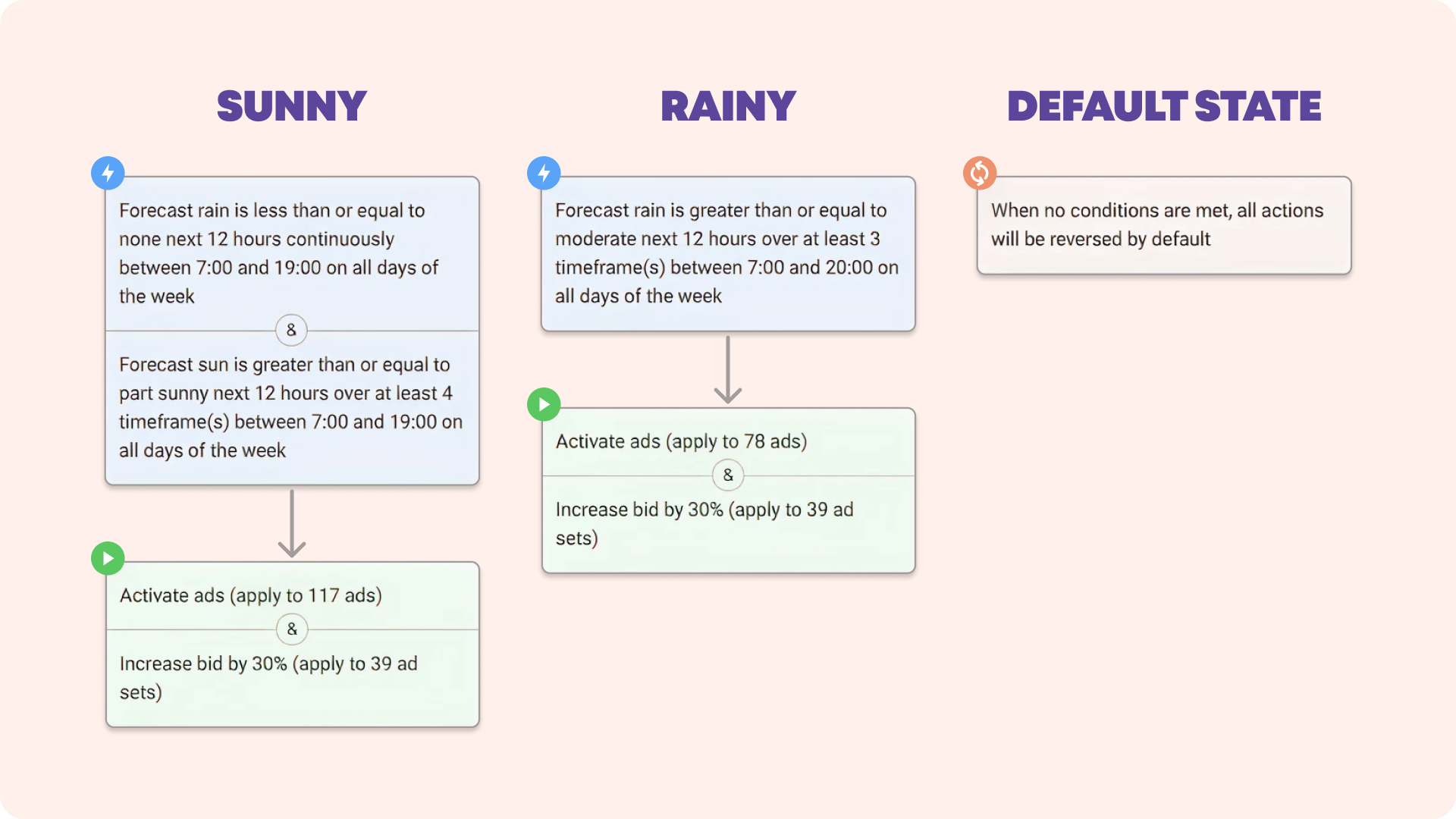You don’t need to be a meteorologist to know that the weather shapes how we spend, dress, travel, and plan our day.
Whether it’s a heatwave, a cold snap, or just a sunny afternoon, weather affects our mood, our movements, and our choices. For marketers, that’s a huge opportunity.

Why weather matters more than you think
It’s easy to underestimate how much the weather shapes consumer behaviour.
On rainy days, we stay inside and order a takeaway. Whenever there is a hint of sunshine, garden centres are packed and travel websites are bombarded with clicks. And during a heatwave, that fan you ignored all year is now sold out.
Weather changes what we do and what we buy. In fact, “70% of consumers say weather influences their day-to-day decisions.”
It also changes how we respond to ads
The same message that gets ignored on a wet Monday might land perfectly on a warm Friday afternoon. That’s where weather targeting comes in, helping your ads adapt to the moment, instead of just pushing out the same message to everyone, everywhere.
What does weather targeting mean?
Weather targeting makes digital campaigns responsive to local conditions. Instead of serving the same ads across the board, your creative and messaging adapt based on what’s happening outside.
Let’s say you’re an online clothing store. If it’s raining in Leeds, your ads might show waterproof jackets and boots. Meanwhile, in London, where it’s sunny, you promote sunglasses and sandals. Using weather targeting to do this means no manual updates, and no wasted spend.
You can apply this logic across industries:
- Home improvement retailers pushing outdoor paint when a dry spell hits
- Travel brands suggesting last-minute getaways during grey spells
- Hospitality brands ramping up promos when warmer evenings boost bookings
- Pet care brands promoting flea treatments during peak heat periods
At its best, weather targeting helps your ads feel more timely, personal, and useful, without the heavy lifting.
How weather targeting works (in practice)
There are a few different ways to implement weather targeting in Google Ads and other paid platforms:
1. Weather APIs and third-party tools
These connect your media platform to live weather data, using automated rules to adjust:
- Copy and creative
- Bids and budgets
- Locations activated or paused
Many of these tools are plug-and-play, but some require light setup or API access.
2. Google Ads scripts
For more advanced teams, weather targeting in Google Ads can be achieved through custom scripts. These pull in data (e.g. current temperature, wind, rain) and trigger rule-based changes in your campaigns, all in real-time. The downside of this is that bid strategies often are not compatible with this approach, and manual bidding would need to be enabled, adding complexity.
This means:
- Bids increase when weather conditions favour higher demand
- Ads switch depending on whether it's raining, snowing, or sunny
- Campaigns can pause or resume automatically depending on the forecast
It’s not one-size-fits-all
Like most things in marketing, success with weather targeting comes down to the details.
- What types of weather data matter most for your audience?
- How granular should you go with geo-locations?
- Which thresholds (temperature, rainfall, etc.) trigger changes?
- How often should your campaigns adapt?
Some brands might only need one or two smart switches. Others could benefit from highly dynamic campaigns with lots of weather conditions driving actions.
The key is to match your strategy to your audience, your goals, and your product seasonality.
Why it works
Getting the message right, at the right moment, has an impact across the full funnel:
- People are more likely to notice an ad that fits their mood or situation
- They’re more likely to click if it’s timely and useful
- They’re more likely to buy if the product feels relevant
Done well, weather targeting in Google Ads campaigns can boost engagement, conversions, and overall return on ad spend, all while keeping things efficient.
A quick word on automation
One of the biggest wins of using weather targeting is scale.
Using automation means thousands of small campaign adjustments happen daily, in the background, across platforms. This means:
- Less manual tweaking
- More efficient spending
- Smarter local optimisation across multiple markets
It’s campaign optimisation that reacts faster than the forecast.

Final thoughts
Weather is one of those variables that can feel hard to control. But in marketing, you don’t have to control it, you just have to respond to it strategically.
When you tap into live conditions and align your messaging accordingly, you stand a better chance of standing out. This means better customer experiences and better campaign performance.
Do you need help making weather work for you?
We’ve helped brands build smarter, more responsive campaigns using weather data across retail and e-commerce. If you’re curious about how this could work for you, we’d love to chat.

Ready. Steady. Grow!
We've helped some of the world's biggest brands transform and grow their businesses. And yours could be next.
So if you've got a business challenge to solve or a brief to answer, we'd love to hear from you. Simply complete this form and one of our experts will be in touch!




